A Highly Sensitive D-Shaped PCF-SPR Sensor for Refractive Index and Temperature Detection
Abstract
1. Introduction
2. Design of Dual-Parameter PCF-SPR Sensor
3. Sensor Model Manufacturing Procedure
4. Results and Discussion
4.1. Dispersion Relation
4.2. Confinement Loss Spectra
4.3. Dual-Channel Independence
4.4. Sensitivity-Based Performance
4.5. Sensor Resolution
4.6. Structural Parameter Variation
5. Conclusions
Author Contributions
Funding
Institutional Review Board Statement
Informed Consent Statement
Data Availability Statement
Conflicts of Interest
References
- Liu, Y.; Li, S.; Chen, H.; Li, J.; Zhang, W.; Wang, M. Surface plasmon resonance induced high sensitivity temperature and refractive index sensor based on evanescent field enhanced photonic crystal fiber. J. Light. Technol. 2019, 38, 919–928. [Google Scholar] [CrossRef]
- Khani, S.; Danaie, M.; Rezaei, P. Miniaturized microstrip dual-band bandpass filter with wide upper stop-band bandwidth. Analog. Integr. Circuits Signal Process. 2019, 98, 367–376. [Google Scholar] [CrossRef]
- Zhao, T.; Asghari, M.; Mehdizadeh, F. An all-optical digital 2-to-1 multiplexer using photonic crystal-based nonlinear ring resonators. J. Electron. Mater. 2019, 48, 2482–2486. [Google Scholar] [CrossRef]
- Daghooghi, T.; Soroosh, M.; Ansari-Asl, K. A low-power all optical decoder based on photonic crystal nonlinear ring resonators. Optik 2018, 174, 400–408. [Google Scholar] [CrossRef]
- Wang, Y.; Li, S.; Guo, Y.; Zhang, S.; Li, H. Surface plasmon polariton high-sensitivity refractive index sensor based on MMF-MOF-MMF structure. Infrared Phys. Technol. 2021, 114, 103685. [Google Scholar] [CrossRef]
- Rifat, A.A.; Ahmed, R.; Yetisen, A.K.; Butt, H.; Sabouri, A.; Mahdiraji, G.A.; Yun, S.H.; Adikan, F.M. Photonic crystal fiber based plasmonic sensors. Sens. Actuators B Chem. 2017, 243, 311–325. [Google Scholar] [CrossRef]
- Shalabney, A.; Abdulhalim, I. Sensitivity-enhancement methods for surface plasmon sensors. Laser Photonics Rev. 2011, 5, 571–606. [Google Scholar] [CrossRef]
- Liu, Y.; Chen, H.; Li, H.; Zhang, S.; Gao, Z.; Feng, Y.; Zhang, Y.; Li, S. High-performance surface plasmon resonance refractometer based on a no-core fiber coated with a silver film. JOSA B 2021, 38, 2536–2542. [Google Scholar] [CrossRef]
- Al-Qazwini, Y.; Noor, A.; Al-Qazwini, Z.; Yaacob, M.H.; Harun, S.W.; Mahdi, M. Refractive index sensor based on SPR in symmetrically etched plastic optical fibers. Sens. Actuators A Phys. 2016, 246, 163–169. [Google Scholar] [CrossRef]
- Chen, M.; Lang, T.; Cao, B.; Yu, Y.; Shen, C. D-type optical fiber immunoglobulin G sensor based on surface plasmon resonance. Opt. Laser Technol. 2020, 131, 106445. [Google Scholar] [CrossRef]
- Xue, F.; Yao, Y.; Xu, P.; Luo, J.; Li, L.; Zhang, L.; Liu, E. Ultra-high sensitive refractive index sensor based on D-shaped photonic crystal fiber with graphene-coated Ag-grating. Heliyon 2023, 9, e14921. [Google Scholar] [CrossRef]
- Song, H.; Wang, Q.; Zhao, W.-M. A novel SPR sensor sensitivity-enhancing method for immunoassay by inserting MoS2 nanosheets between metal film and fiber. Opt. Lasers Eng. 2020, 132, 106135. [Google Scholar] [CrossRef]
- Fan, X.; White, I.M. Optofluidic microsystems for chemical and biological analysis. Nat. Photonics 2011, 5, 591–597. [Google Scholar] [CrossRef] [PubMed]
- Ricciardi, A.; Consales, M.; Quero, G.; Crescitelli, A.; Esposito, E.; Cusano, A. Versatile optical fiber nanoprobes: From plasmonic biosensors to polarization-sensitive devices. ACS Photonics 2014, 1, 69–78. [Google Scholar] [CrossRef]
- Jain, S.; Choudhary, K.; Kumar, S. Photonic crystal fiber-based SPR sensor for broad range of refractive index sensing applications. Opt. Fiber Technol. 2022, 73, 103030. [Google Scholar] [CrossRef]
- Al Mahfuz, M.; Hossain, M.A.; Haque, E.; Hai, N.H.; Namihira, Y.; Ahmed, F. Dual-core photonic crystal fiber-based plasmonic RI sensor in the visible to near-IR operating band. IEEE Sens. J. 2020, 20, 7692–7700. [Google Scholar] [CrossRef]
- Meng, X.; Zhao, Y.; Li, J.; Guo, Y.; Li, S.; Guo, H.; Du, H.; Li, Z.; Li, M.; Feng, Y. High-performance plasmonic sensor based on photonic crystal fiber for refractive index and temperature sensing. Infrared Phys. Technol. 2022, 122, 104036. [Google Scholar] [CrossRef]
- Yasli, A.; Ademgil, H.; Haxha, S.; Aggoun, A. Multi-channel photonic crystal fiber based surface plasmon resonance sensor for multi-analyte sensing. IEEE Photonics J. 2019, 12, 1–15. [Google Scholar] [CrossRef]
- Arcas, A.d.S.; Dutra, F.d.S.; Allil, R.C.; Werneck, M.M. Surface plasmon resonance and bending loss-based U-shaped plastic optical fiber biosensors. Sensors 2018, 18, 648. [Google Scholar] [CrossRef]
- Meng, X.; Li, J.; Guo, Y.; Li, S.; Wang, Y.; Bi, W.; Lu, H. An optical-fiber sensor with double loss peaks based on surface plasmon resonance. Optik 2020, 216, 164938. [Google Scholar] [CrossRef]
- Kapoor, V.; Sharma, N.K. Surface plasmon resonance-based fiber optic sensor prepared from bilayers of indium tin oxide-indium oxide. Microw. Opt. Technol. Lett. 2020, 62, 2439–2443. [Google Scholar] [CrossRef]
- Zeng, S.; Hu, S.; Xia, J.; Anderson, T.; Dinh, X.-Q.; Meng, X.-M.; Coquet, P.; Yong, K.-T. Graphene–MoS2 hybrid nanostructures enhanced surface plasmon resonance biosensors. Sens. Actuators B Chem. 2015, 207, 801–810. [Google Scholar] [CrossRef]
- Luan, N.; Wang, R.; Lv, W.; Lu, Y.; Yao, J. Surface plasmon resonance temperature sensor based on photonic crystal fibers randomly filled with silver nanowires. Sensors 2014, 14, 16035–16045. [Google Scholar] [CrossRef]
- Yang, L.; Hu, C.; Zhao, Y.; Yi, Z.; Liu, Q.; Liu, C.; Lv, J.; Chu, P.K. SPR-based PCF sensor with embedded silver wires for wide range temperature sensing. J. Opt. 2023, 52, 1197–1205. [Google Scholar] [CrossRef]
- Guo, Y.; Li, J.; Li, S.; Liu, Y.; Meng, X.; Bi, W.; Lu, H.; Cheng, T.; Hao, R. Amphibious sensor of temperature and refractive index based on D-shaped photonic crystal fibre filled with liquid crystal. Liq. Cryst. 2020, 47, 882–894. [Google Scholar] [CrossRef]
- Gao, Z.; Feng, Y.; Chen, H.; Chen, Q.; Li, Y.; Zhang, M. Refractive index and temperature sensing system with high sensitivity and large measurement range using an optical fiber. IEEE Trans. Instrum. Meas. 2023, 72, 1–6. [Google Scholar] [CrossRef]
- Yin, Z.; Jing, X. Theoretical study of a broadband dual-channel sensor based on sodium-based SPR. Photonics Nanostruct. Fundam. Appl. 2023, 55, 101146. [Google Scholar] [CrossRef]
- Ullah, S.; Chen, H.; Yin, Z.; Li, H.; Li, Y.; Zhang, T.; Wang, C.; Guo, P.; Li, S. A high sensitivity refractive index sensor based on microstructure fiber with simple structure and SPR effect. Phys. Scr. 2024, 99, 055907. [Google Scholar] [CrossRef]
- Kadhim, R.A.; Wu, J.; Wang, Z. Sensitivity enhancement of a plasmonic sensor based on a side opening quasi-d-shaped optical fiber with au nanowires. J. Opt. 2022, 51, 71–78. [Google Scholar] [CrossRef]
- Yang, H.; Wang, G.; Lu, Y.; Yao, J. Highly sensitive refractive index sensor based on SPR with silver and titanium dioxide coating. Opt. Quantum Electron. 2021, 53, 341. [Google Scholar] [CrossRef]
- Kamrunnahar, Q.; Mou, J.R.; Momtaj, M. Dual-core gold coated photonic crystal fiber plasmonic sensor: Design and analysis. Results Phys. 2020, 18, 103319. [Google Scholar] [CrossRef]
- Zhu, Z.; Liu, L.; Liu, Z.; Zhang, Y.; Zhang, Y. Surface-plasmon-resonance-based optical-fiber temperature sensor with high sensitivity and high figure of merit. Opt. Lett. 2017, 42, 2948–2951. [Google Scholar] [CrossRef] [PubMed]
- Russell, P. Photonic crystal fibers. Science 2003, 299, 358–362. [Google Scholar] [CrossRef] [PubMed]
- Mustafa, Q.M.S.; Kadhim, R.A.; Vahed Kalankesh, H.; Pourziad, A. Dual-channel plasmonic refractive index sensor based on H-shaped optical fibres for multi-analyte detection. J. Opt. 2023, 52, 1171–1179. [Google Scholar] [CrossRef]

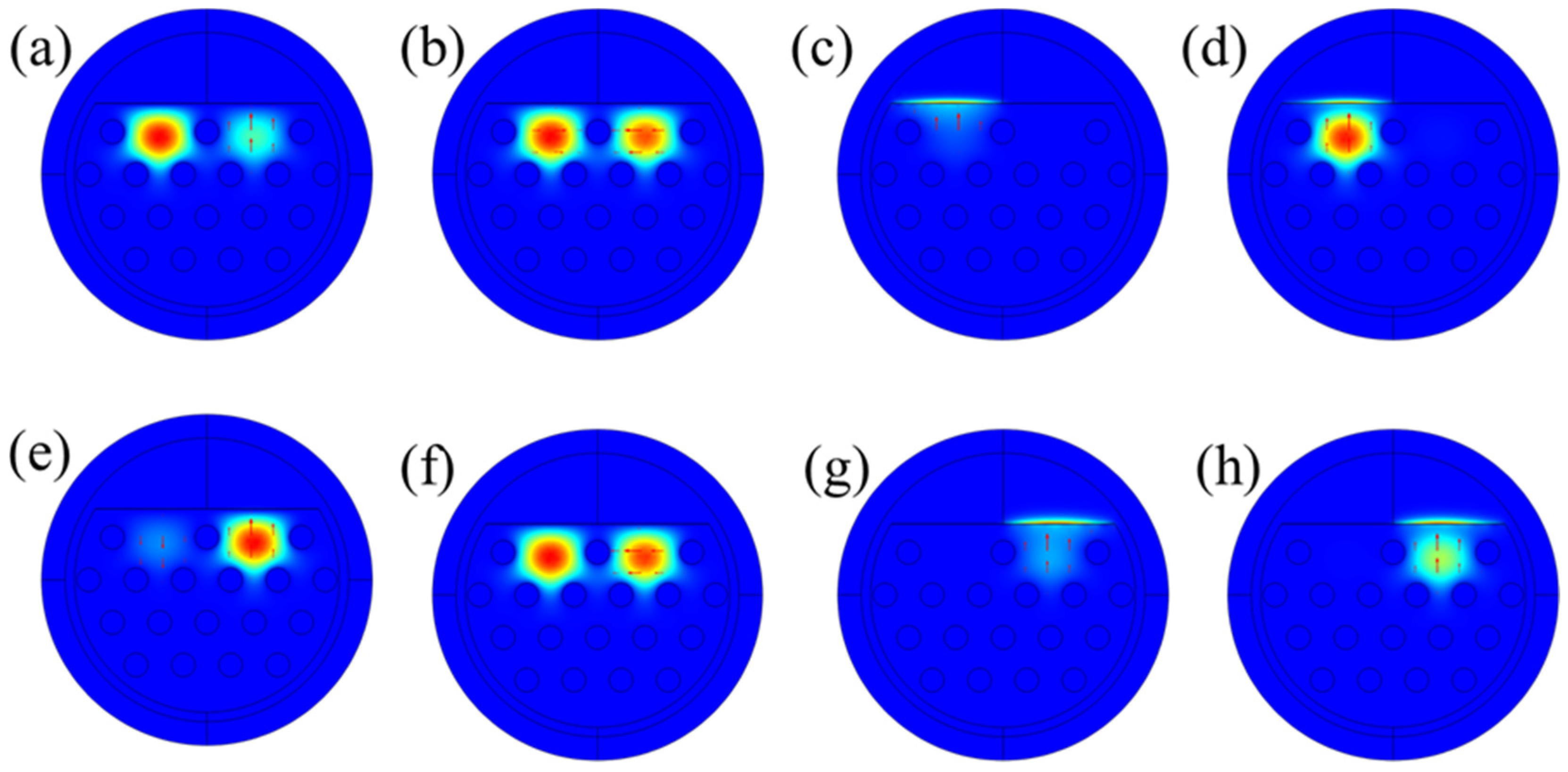
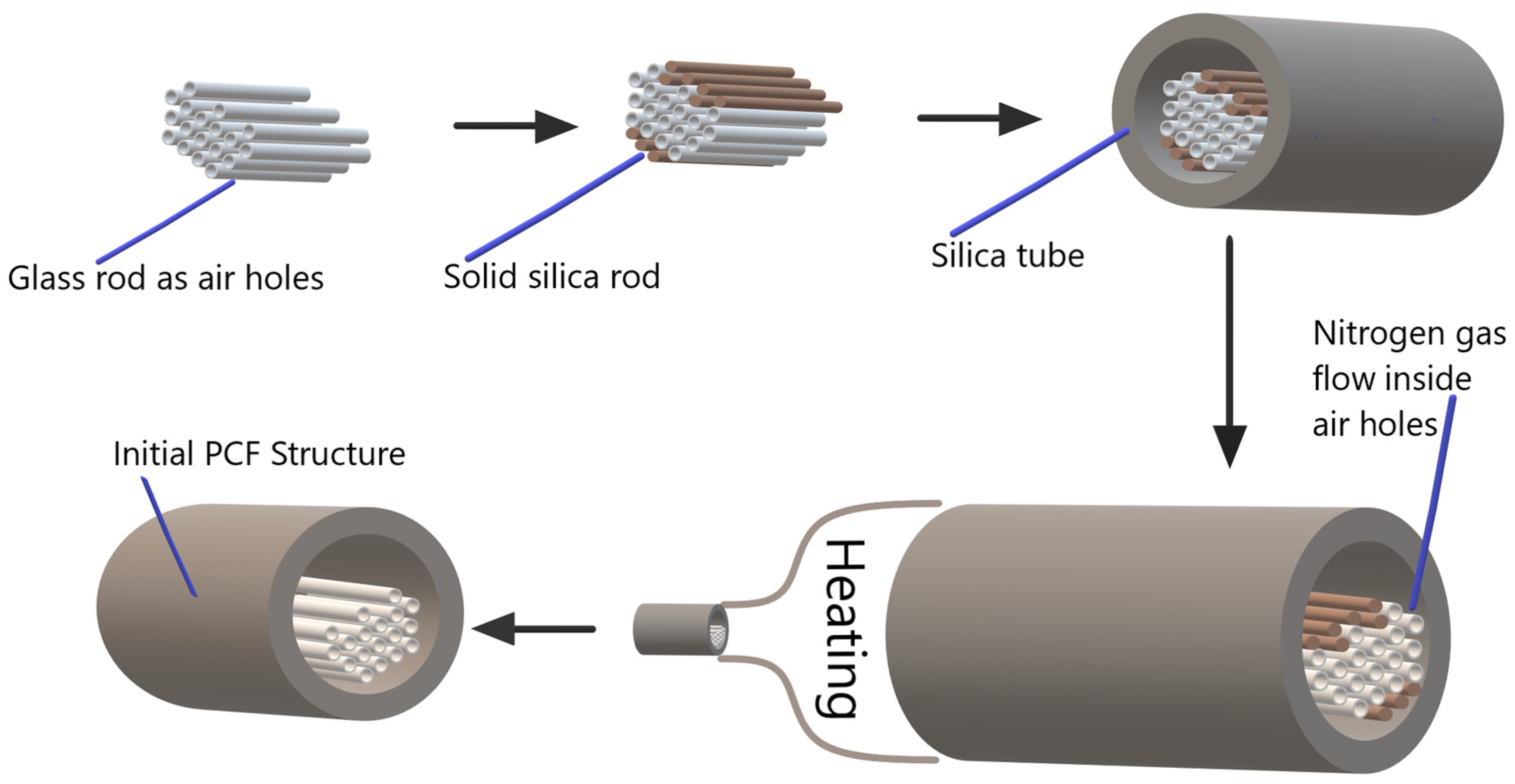
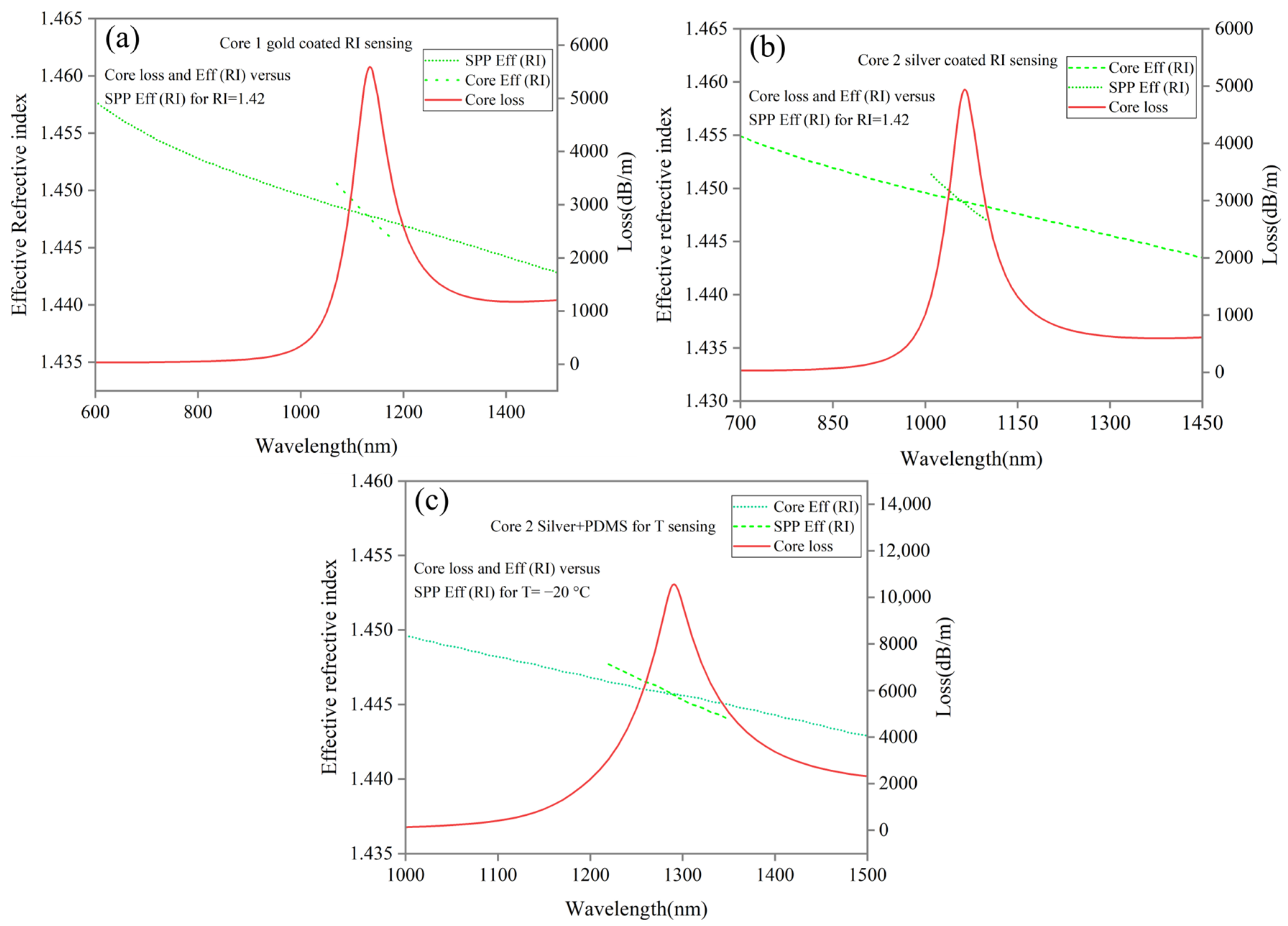
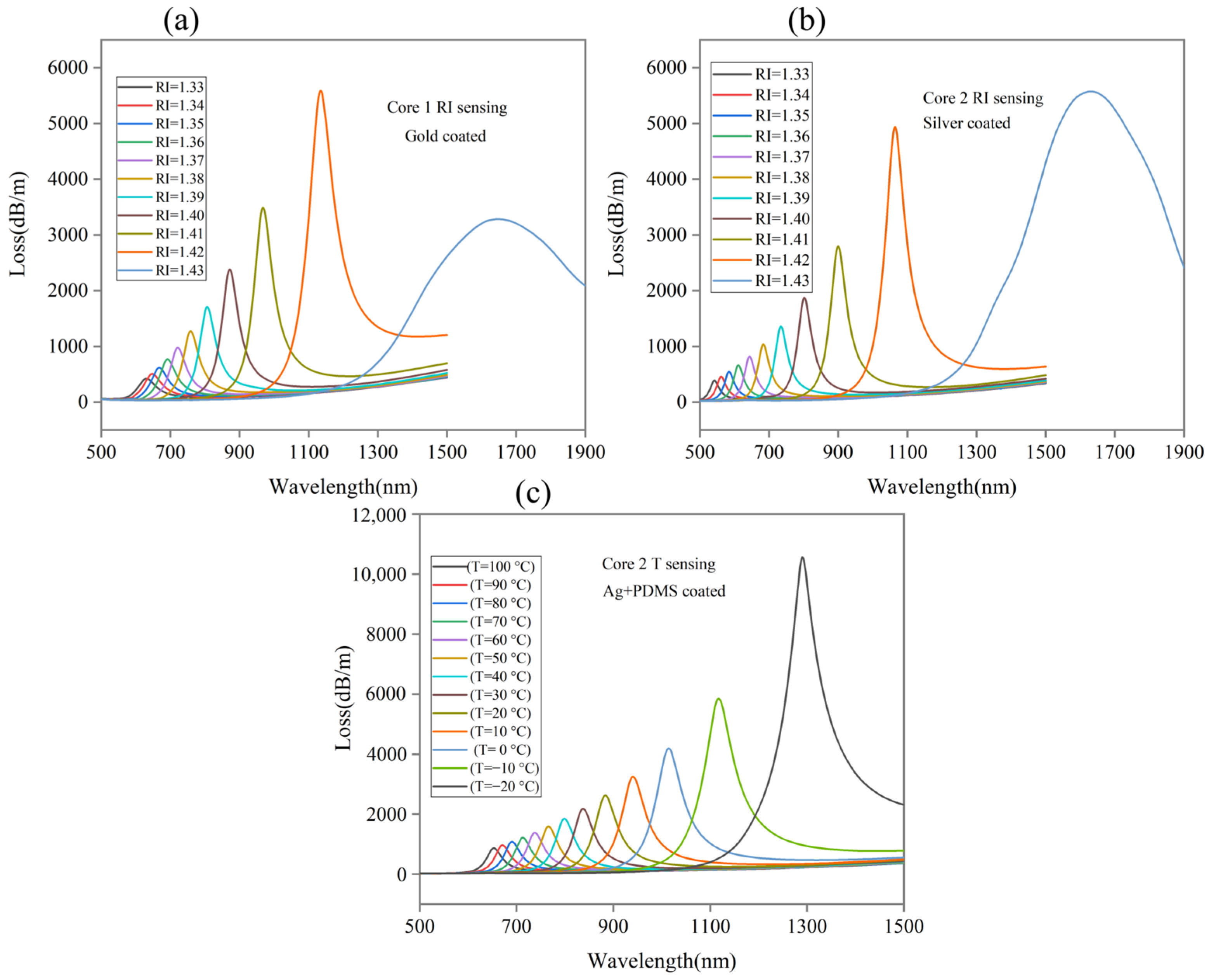
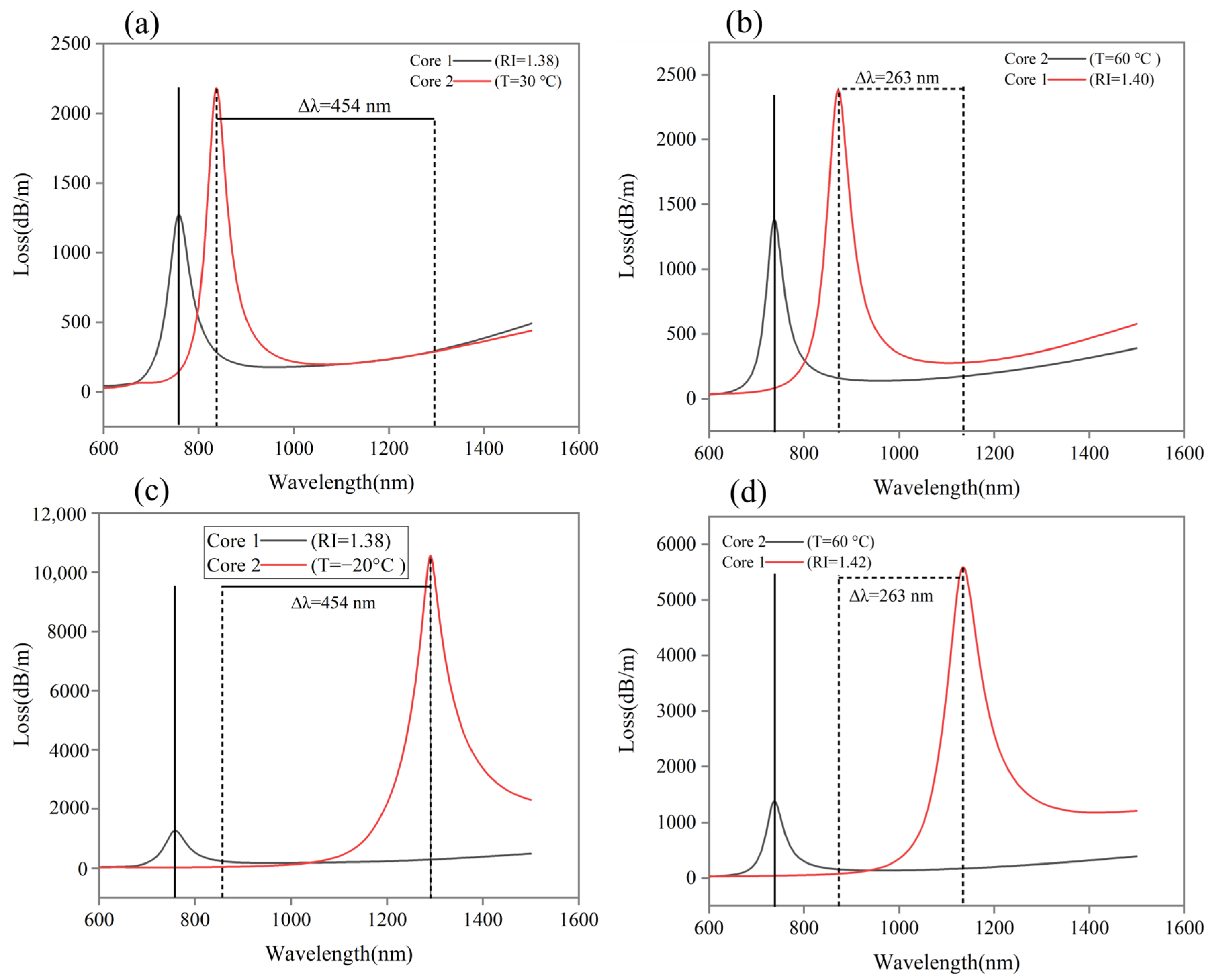



| Cladding radius R = 28 µm | Air hole radius r = 2.5 µm | Pitch 1 ᴧ1 = 10 µm | Pitch 2 ᴧ2 = 12 µm | Gold thickness tg = 50 nm |
| Silver thickness ts = 50 nm | Polishing depth d = 13 µm | Analyte layer a = 2 µm | Perfectly matched layer PML = 5 µm |
| Physical Significance | Dielectric Constant Frequency | Plasma Frequency | Weighting Factor | Frequency of Lorentz Oscillator | Damping Frequency | Spectral Width | Reference | |
|---|---|---|---|---|---|---|---|---|
| Metal | Constant | ε∞ | ωD/2π (THz) | Δε | ΩL/2π (THz) | γD/2π (THz) | ΓL/2π | |
| Ag | 2.4064 | 2214.6 | 1.6604 | 1330.1 | 4.8 | 620.7 | [30] | |
| Au | 5.9673 | 2113.6 | 1.09 | 650.07 | 15.92 | 104.86 | [31] |
| Temp (°C) = | −20 | −10 | 0 | 10 | 20 | 30 | 40 | 50 | 60 |
| nPDMS = | 1.4266 | 1.4221 | 1.4176 | 1.4131 | 1.4086 | 1.4041 | 1.3996 | 1.8951 | 1.3906 |
| Temp (°C) = | 70 | 80 | 90 | 100 | |||||
| nPDMS = | 1.3861 | 1.3816 | 1.3771 | 1.3726 |
| RI | Loss (dB/m) | Resonance Wavelength (nm) | Analyte (RI) Difference | Resonance Wavelength SHIFT (nm) | Refractive Index SENSITIVITY (nm/RIU) | Resolution (RIU) |
|---|---|---|---|---|---|---|
| 1.33 | 422.16 | 631 | 1.34–1.33 | 17 | 1700 | 5.88 × 10−5 |
| 1.34 | 506.36 | 648 | 1.35–1.34 | 20 | 2000 | 5.00 × 10−5 |
| 1.35 | 617.97 | 668 | 1.36–1.35 | 24 | 2400 | 4.16 × 10−5 |
| 1.36 | 768.62 | 692 | 1.37–1.36 | 30 | 3000 | 3.33 × 10−5 |
| 1.37 | 976.79 | 722 | 1.38–1.37 | 37 | 3700 | 2.70 × 10−5 |
| 1.38 | 1272.7 | 759 | 1.39–1.38 | 48 | 4800 | 2.08 × 10−5 |
| 1.39 | 1708 | 807 | 1.40–1.39 | 65 | 6500 | 1.54 × 10−5 |
| 1.40 | 2380 | 872 | 1.41–1.40 | 96 | 9600 | 1.04 × 10−5 |
| 1.41 | 3488.9 | 968 | 1.42–1.41 | 167 | 16,700 | 5.99 × 10−6 |
| 1.42 | 5589.5 | 1135 | 1.43–1.42 | 512 | 51,200 | 1.95 × 10−6 |
| 1.43 | 3283.7 | 1647 |
| RI | Loss (dB/m) | Resonance Wavelength (nm) | Analyte (RI) Difference | Resonance Wavelength Shift (nm) | Refractive Index Sensitivity (nm/RIU) | Resolution (RIU) |
|---|---|---|---|---|---|---|
| 1.33 | 387.62 | 542 | 1.34–1.33 | 20 | 2000 | 5.00 × 10−5 |
| 1.34 | 457.36 | 562 | 1.35–1.34 | 22 | 2200 | 4.54 × 10−5 |
| 1.35 | 546.06 | 584 | 1.36–1.35 | 27 | 2700 | 3.70 × 10−5 |
| 1.36 | 662.26 | 611 | 1.37–1.36 | 32 | 3200 | 3.12 × 10−5 |
| 1.37 | 817.79 | 643 | 1.38–1.37 | 41 | 4100 | 2.44 × 10−5 |
| 1.38 | 1036.7 | 684 | 1.39–1.38 | 50 | 5000 | 2.00 × 10−5 |
| 1.39 | 1358 | 734 | 1.40–1.39 | 68 | 6800 | 1.47 × 10−5 |
| 1.40 | 1873.7 | 802 | 1.41–1.40 | 98 | 9800 | 1.02 × 10−5 |
| 1.41 | 2795 | 900 | 1.42–1.41 | 164 | 16,400 | 6.09 × 10−6 |
| 1.42 | 4936.4 | 1064 | 1.43–1.42 | 567 | 56,700 | 1.76 × 10−6 |
| 1.43 | 5575.3 | 1631 |
| PDMS (RI) | Loss (dB/m) | Resonance Wavelength (nm) | Temperature (°C) | Resonance Wavelength Shift (nm) | Temperature Sensitivity (nm/°C) | Resolution (RIU) |
|---|---|---|---|---|---|---|
| 1.3726 | 868.19 | 653 | 100 | 18 | 1.8 | 5.55 × 10−2 |
| 1.3771 | 965.61 | 671 | 90 | 20 | 2.0 | 5.00 × 10−2 |
| 1.3816 | 1080.1 | 691 | 80 | 22 | 2.2 | 4.54 × 10−2 |
| 1.3861 | 1217.2 | 713 | 70 | 25 | 2.5 | 4.00 × 10−2 |
| 1.3906 | 1382.1 | 738 | 60 | 28 | 2.8 | 3.57 × 10−2 |
| 1.3951 | 1588 | 766 | 50 | 33 | 3.3 | 3.03 × 10−2 |
| 1.3996 | 1847.6 | 799 | 40 | 38 | 3.8 | 2.63 × 10−2 |
| 1.4041 | 2179.8 | 837 | 30 | 47 | 4.7 | 2.12 × 10−2 |
| 1.4086 | 2624.3 | 884 | 20 | 56 | 5.6 | 1.79 × 10−2 |
| 1.4131 | 3246.2 | 940 | 10 | 74 | 7.4 | 1.35 × 10−2 |
| 1.4176 | 4191.7 | 1014 | 0 | 103 | 10.3 | 9.70 × 10−3 |
| 1.4221 | 5849 | 1117 | −10 | 174 | 17.4 | 5.74 × 10−3 |
| 1.4266 | 10561 | 1291 | −20 |
| Type of Sensors | WL Range RI (nm) | Range in Term of (RI) | W.S (nm/RIU) | A.S (RIU−1) | Resolution (RIU) | Ref. |
|---|---|---|---|---|---|---|
| T (nm) | T | (nm/°C) | (°C−1) | |||
| High-sensitivity SPR-PCF sensor for RI and T | 1.43–1.50 | 36–86 | 44,850 | NA | NA | [1] |
| 16.875 | ||||||
| Ultra-high-sensitivity D-shaped PCF RI sensing | NA | 1.33–1.395 | 18,612 | NA | 4.16 × 10−6 | [11] |
| 20–60 | 2.0 | |||||
| PCF-SPR for wide range of RI sensing | 500–1350 | 1.35–1.40 | 10,000 | 1115 | 2 × 10−5 | [15] |
| Dual-Core PCF-SPR for RI sensing | 576–896 | 1.33–1.42 | 28,000 | 6829 | 3.57 ×10−6 | [16] |
| Amphibious T and RI sensor with a D shape | 2097–1078 | 1.0–1.6 | 2275 | −88.2 | [25] | |
| 15–50 | 9.09 | −0.311 | ||||
| Broadband dual-channel sensor | 600–1050 | 1.33–1.41 | 8700 | NA | 2.32 × 10−5 | [27] |
| 1051–1700 | 0–50 | 20.2 | 9.36 × 10−3 | |||
| H-Shaped Dual-Channel SPR sensor | NA | 1.33–1.36/1.37–1.40 | 4000/10,500 | 484/288 | 2.5 × 10−5/9.09 × 10−6 | [34] |
| Dual-Core PCF-SPR for RI | 450–1150 | 1.33–1.44 | 11,200 | 505.037 | 8.92 × 10−6 | [31] |
| Our previous work of highly sensitive PCF-SPR sensor for RI sensing | 632–1269 | 1.33–1.42 | 27,400 | 100.43 | 3.64 × 10−6 | [28] |
| Dual-Core PCF-SPR for RI and T sensing | 542–1647 | 1.33–1.43 | 51,200/56,700 | 98.9/147.6 | 1.95 × 10−6/1.76 × 10−6 | This work |
| 653–1291 | −20–100 | 17.4 | NA | 5.74 × 10−3 |
Disclaimer/Publisher’s Note: The statements, opinions and data contained in all publications are solely those of the individual author(s) and contributor(s) and not of MDPI and/or the editor(s). MDPI and/or the editor(s) disclaim responsibility for any injury to people or property resulting from any ideas, methods, instructions or products referred to in the content. |
© 2024 by the authors. Licensee MDPI, Basel, Switzerland. This article is an open access article distributed under the terms and conditions of the Creative Commons Attribution (CC BY) license (https://creativecommons.org/licenses/by/4.0/).
Share and Cite
Ullah, S.; Chen, H.; Guo, P.; Song, M.; Zhang, S.; Hu, L.; Li, S. A Highly Sensitive D-Shaped PCF-SPR Sensor for Refractive Index and Temperature Detection. Sensors 2024, 24, 5582. https://doi.org/10.3390/s24175582
Ullah S, Chen H, Guo P, Song M, Zhang S, Hu L, Li S. A Highly Sensitive D-Shaped PCF-SPR Sensor for Refractive Index and Temperature Detection. Sensors. 2024; 24(17):5582. https://doi.org/10.3390/s24175582
Chicago/Turabian StyleUllah, Sajid, Hailiang Chen, Pengxiao Guo, Mingshi Song, Sa Zhang, Linchuan Hu, and Shuguang Li. 2024. "A Highly Sensitive D-Shaped PCF-SPR Sensor for Refractive Index and Temperature Detection" Sensors 24, no. 17: 5582. https://doi.org/10.3390/s24175582
APA StyleUllah, S., Chen, H., Guo, P., Song, M., Zhang, S., Hu, L., & Li, S. (2024). A Highly Sensitive D-Shaped PCF-SPR Sensor for Refractive Index and Temperature Detection. Sensors, 24(17), 5582. https://doi.org/10.3390/s24175582







